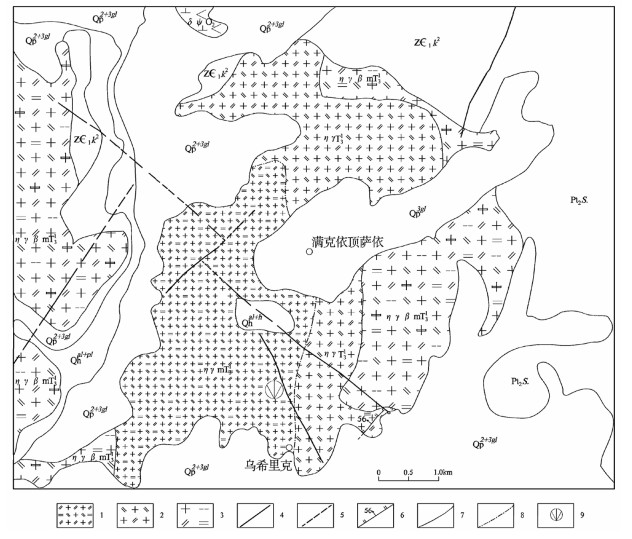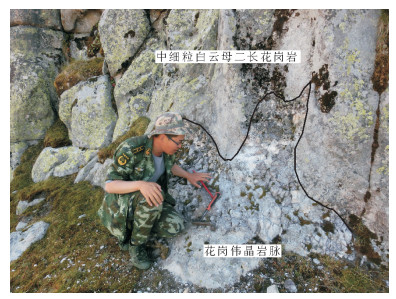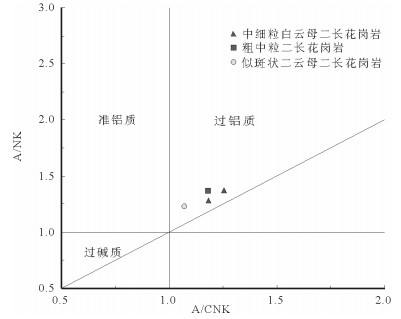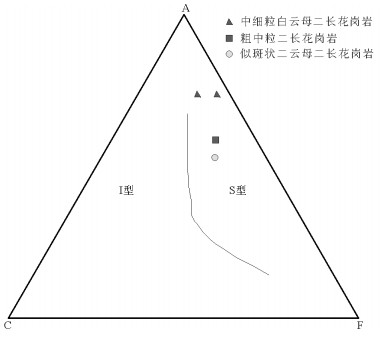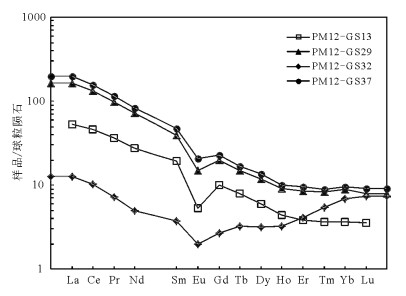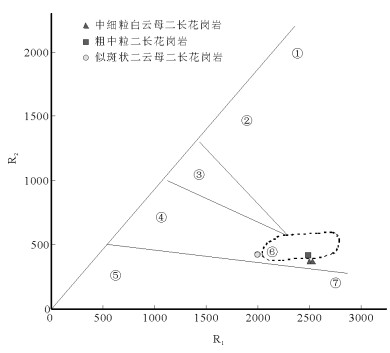Geochemical characteristics, formation age and tectonic environment of the Mankeyidingsayi rocks in the Wuxilike area of Altay
-
摘要:
阿尔泰乌希里克地区位于西伯利亚板块阿尔泰陆缘活动带的阿尔泰古生代深成岩浆弧内,花岗岩广泛分布。通过对满克依顶萨依岩体进行LA-ICP-MS锆石U-Pb测年和岩石地球化学分析,探讨该岩体形成的时代及构造环境。乌希里克南部满克依顶萨依岩体中细粒白云母二长花岗岩的LA-ICP-MS锆石U-Pb年龄为217.9±2.3Ma,表明岩体侵位于早中生代晚三叠世早期。岩石具有高的SiO2(70.86%~74.32%)和Al2O3(14.51%~14.96%)含量,低P2O5(0.24%~0.33%)和MgO+FeO(0.39%~1.25%)含量,富碱(K2O+Na2O=8.07%~8.29%),具有低的CaO/Na2O值(0.13~0.30,≤0.3)。以上特征表明,该岩体属高钾钙碱性过铝质岩类,具有S型花岗岩的典型特征。结合前人研究成果综合分析,推测岩体形成于板内(陆内)环境,与地幔柱有关。岩体主要由源自地壳的泥质沉积物部分熔融形成,在部分熔融过程中有富钙的斜长石、钛铁矿等矿物的残留。
Abstract:The Wuxilike area of Altay is located in Siberian Altay terrigenous mobile belt and the Altay Paleozoic plutonic magmatic arc, where granite is widely distributed. By LA-ICP-MS zircon U-Pb dating and geochemical analysis, the authors studied the age and tectonic environment of the Makeyidingshayi granite body. The LA-ICP-MS zircon U-Pb age of the medium-fine grained muscovite adamellite of Mankeyidingsayi granite body in southern Wuxilike area is 217.9±2.3Ma, showing that the granite body was emplaced in the early Late Triassic of the early-Mesozoic. The rocks have high SiO2 (70.86%~74.32%) and Al2O3 (14.51%~14.96%), low P2O5 (0.24%~0.33%) and MgO+FeO (0.39%~1.25%) content, high alkali (K2O+Na2O=8.07%~8.29%), and low CaO/Na2O (0.13~0.30, ≤0.3) ratio. These characteristics indicate that the granite body belongs to high-K calc-alkaline peraluminous rocks, with the typical features of S-type granites. In combination with the work and the results from previous comprehensive analysis, the authors infer that the granite body was formed in an intercontinental (inland) environment, related to the mantle plume. The granite body was mainly derived from partial melting of argillaceous sediments in the crust, and during the partial melting process, residuals of calcium-rich plagioclase, ilmenite and other minerals were preserved.
-
Keywords:
- geochemical characteristics /
- formation age /
- tectonic environment /
- Mankeyidingsayi /
- Wuxilike /
- Altay
-
阿尔泰造山带属于中亚造山带的一个重要组成部分,占据特殊的地位,其与整个中亚造山带一样发育大量的花岗岩。前人对中国阿尔泰花岗岩做了很多研究,积累了丰富的资料,认为这些花岗岩具有多时代、多类型、多成因、多来源等特征,形成于多种构造环境[1-9],并对其基本特征进行了初步总结[9]。这些花岗岩被认为主体形成于晚古生代,阿尔泰造山带也多被认为是晚古生代(华力西)造山带。近年来精确的同位素年龄研究显示,其峰值年龄主要为460Ma、408Ma、375Ma和265Ma,尤其是400Ma左右的花岗质岩浆活动最剧烈。相对而言,印支期岩浆活动较弱,对其成岩时代、岩浆形成构造环境、演化等的研究较欠缺,仅有将军山岩体、尚克兰岩体、阿拉尔岩体等少量岩体的相关研究见诸报端[10-11]。由于以前的花岗岩类年龄数据跨度大、精确度不高(多为全岩K-Ar法),有些结果并不代表岩体的侵位年龄,且同位素年龄测定无论在方法、对象,还是样品代表性上均存在较大的局限性,制约了对阿尔泰地区构造环境、构造演化、造山作用及地壳增生的进一步认识。
2013—2015年,笔者在阿尔泰乌齐里克他乌一带开展1:5万区域地质矿产调查期间,对工作区内的卡朗岩基进行了详细调查,解体出满克依顶萨依花岗岩体。本文通过对该岩体的岩相学、岩石地球化学和LA-ICP-MS锆石U-Pb测年分析,探讨岩石成因及形成的构造背景,为进一步探讨该区的造山作用和大陆地壳的形成、演化提供新的依据。
1. 区域地质背景
阿尔泰造山带位于中亚造山带的东南部,呈北西—南东向横贯于中、俄、哈、蒙四国,全长2000km,在中国境内长约500km。在大地构造上,中国阿尔泰造山带位于额尔齐斯-布尔根板块缝合带以北的西伯利亚板块[12],包括北阿尔泰早古生代陆缘活动带(包括诺尔特泥盆纪—石炭纪上叠火山-沉积盆地、喀纳斯-可可托海古生代岩浆弧)、南阿尔泰晚古生代活动陆缘(克兰泥盆纪-石炭纪弧后盆地、卡尔巴-纳雷姆石炭纪-二叠纪岩浆弧和西卡尔巴石炭纪弧前盆地)[13](图 1)。
![]() 图 1 阿尔泰造山带区域地质及花岗岩分布略图(据参考文献[13]修改)Figure 1. Geological sketch map of the Altay orogenic belt, showing the distribution of granites
图 1 阿尔泰造山带区域地质及花岗岩分布略图(据参考文献[13]修改)Figure 1. Geological sketch map of the Altay orogenic belt, showing the distribution of granites综合前人研究成果[10, 12, 14-16],认为阿尔泰造山带于前寒武世晚期—早古生代早期为稳定大陆边缘环境,大致从晚寒武世开始发生俯冲、增生,其中,早古生代(奥陶纪—泥盆纪)为洋壳俯冲阶段,之后可能发生碰撞造山作用,于中石炭世基本奠定了阿尔泰造山带的构造格局,而额尔齐斯以南即准噶尔造山带,在石炭纪可能仍有俯冲碰撞作用发生[17]。
研究区位于北阿尔泰早古生代陆缘活动带内喀纳斯-可可托海古生代岩浆弧中,地层主要为震旦系—下寒武统喀纳斯群,该区处于阿尔泰陆缘活动带之阿尔泰古生代深成岩浆弧带与南阿尔泰晚古生代活动陆缘交会部位,构造活动十分频繁,侵入岩非常发育,从基性岩到酸性岩均有出露,尤其是花岗岩类岩体数量多、规模大、类型多样,满克依顶萨依岩体侵位于卡朗岩体东部喀纳斯群中。
2. 岩体地质及岩相学
2.1 岩体地质
满克依顶萨依岩体呈近椭圆状分布,面积约35km2,长轴方向与北东向构造线方向一致,侵位于震旦系—寒武系喀纳斯群中(图 2)。整体上,岩性为灰白色二长花岗岩,根据野外交切关系可以划分为3个侵入次:第一侵入次为灰白色中细粒白云母二长花岗岩,第二侵入次为灰白色似斑状二云母二长花岗岩,第三侵入次为灰白色粗中粒二长花岗岩。中细粒白云母二长花岗岩位于岩体西部,出露面积最大,呈近长方形产出。似斑状二云母二长花岗岩位于岩体东部,呈岩枝状产出,接触界线非常清晰,岩体形态不规则。粗中粒二长花岗岩呈楔形侵位于中细粒白云母二长花岗岩和似斑状二云母二长花岗岩之间,总体呈南北向长条状展布,中间被上更新统冰碛堆积物覆盖,与西部中细粒白云母二长花岗岩呈脉动接触,与东部似斑状二云母二长花岗岩呈侵入接触。灰白色中细粒白云母二长花岗岩体中共生大量花岗伟晶岩脉(图 3),规模均较小,但脉岩中发育很多绿柱石。绿柱石晶形基本完好,晶体呈六方柱形,柱面有纵纹,多为浅绿色和黄色。
![]() 图 2 研究区侵入岩分布简图1—中细粒白云母二长花岗岩;2—粗中粒二长花岗岩;3—中粗粒似斑状二云母二长花岗岩;4—实测性质不明断层;5—推测性质不明断层;6—实测正断层;7—实测整合岩层界线;8—花岗岩体脉动接触界线;9—同位素样品采样点;Qhal+pl—全新统冲洪积;Qp3gl—上更新统冰碛堆积;Qp2+3gl—中-上更新统冰碛堆积;Z∈1k2—震旦系-寒武系喀纳斯群;ηγmT31—晚三叠世中细粒白云母二长花岗岩;ηγT31—晚三叠世粗中粒二长花岗岩;ηγβmT31—晚三叠世中粗粒似斑状二云母二长花岗岩;δψO2—中晚奥陶世变质角闪石闪长岩;Pt2S—中元古界苏普特岩群Figure 2. The distribution of intrusive rocks in the study area
图 2 研究区侵入岩分布简图1—中细粒白云母二长花岗岩;2—粗中粒二长花岗岩;3—中粗粒似斑状二云母二长花岗岩;4—实测性质不明断层;5—推测性质不明断层;6—实测正断层;7—实测整合岩层界线;8—花岗岩体脉动接触界线;9—同位素样品采样点;Qhal+pl—全新统冲洪积;Qp3gl—上更新统冰碛堆积;Qp2+3gl—中-上更新统冰碛堆积;Z∈1k2—震旦系-寒武系喀纳斯群;ηγmT31—晚三叠世中细粒白云母二长花岗岩;ηγT31—晚三叠世粗中粒二长花岗岩;ηγβmT31—晚三叠世中粗粒似斑状二云母二长花岗岩;δψO2—中晚奥陶世变质角闪石闪长岩;Pt2S—中元古界苏普特岩群Figure 2. The distribution of intrusive rocks in the study area2.2 主要岩性特征
灰白色中细粒白云母二长花岗岩为不等粒结构,块状构造。岩石主要由钾长石、斜长石、石英等组成(图版Ⅰ-a)。钾长石呈他形不规则状、半自形板状,粒径0.4~2.0mm,条纹结构、格子结构,具白云母化,均匀分布,含量约40%。斜长石呈半自形板状,聚片双晶,粒径0.4~2.5mm,具泥化,均匀分布,含量约28%。石英呈他形粒状,粒径小于2.5mm,具碎裂纹,均匀分布,含量约25%。白云母呈片状,片径小于2.5mm,稀疏分布,含量约7%。
灰白色似斑状二云母二长花岗岩为似斑状结构,块状构造。主要由斑晶和基质组成(图版Ⅰ-b)。斑晶为钾长石,呈板状,粒径8.0×15.0×20.0~11.0×25.0×30.0mm,具卡式双晶,稀疏分布,含量约10%。基质为钾长石、斜长石、石英、白云母和黑云母,钾长石呈半自形板状,粒径0.7~6.0mm,均匀分布,含量约27%;斜长石呈半自形板状,聚片双晶,粒径0.6~5.0mm,具泥化,均匀分布,含量约25%;石英呈他形粒状,粒径小于5.5mm,具碎裂纹,均匀分布,含量约32%;白云母呈片状,片径小于5.5mm,稀疏分布,含量约3%;黑云母呈片状,片径小于5.0mm,稀疏分布,含量约3%。
灰白色粗中粒二长花岗岩呈灰白色,不等粒结构,块状构造。岩石主要由长石、石英等组成(图版Ⅰ-c)。钾长石呈他形不规则状、半自形板状,粒径1.0~10.0mm,条纹结构、格子结构,具白云母化,均匀分布,含量约45%。斜长石呈半自形板状,聚片双晶,粒径0.4~6.0mm,具泥化,均匀分布,含量约25%。石英呈他形粒状,粒径小于3.5mm,具碎裂纹,均匀分布,含量约26%。白云母呈白色鳞片状,片径小于2.5mm,稀疏分布,含量约2%。黑云母呈黑色鳞片状,片径小于3.0mm,稀疏分布,含量约2%。
3. 样品及测试方法
样品均采自新鲜的岩体露头。其中定年样品采自灰白色中细粒白云母二长花岗岩(PM12-TW17,北纬48°01′12.44″、东经88°23′56.18″)。具体采样位置见图 2。
锆石定年由中国地质大学(武汉)地质过程与矿产资源国家重点实验室完成。用常规方法从样品中分选出锆石,在双目镜下挑选出晶形和透明度较好的锆石颗粒。锆石样品靶的制备,首先将挑选好的无色透明、无裂隙、不含包裹体的锆石用环氧树脂固定,待环氧树脂固化后抛光至锆石露出核部,然后进行锆石阴极发光(CL)成像及LA-ICPMS分析。锆石的激光剥蚀电感耦合等离子体质谱(LA-ICP-MS)原位U-Pb定年在中国地质大学(武汉)地质过程与矿产资源国家重点实验室完成。实验采用的ICP-MS为美国Agilent公司生产的Agilent7500a。激光剥蚀系统为德国MicroLas公司生产的GeoLas200M,激光剥蚀时,斑束直径为34μm,频率为8Hz。采样方式为单点剥蚀。每测定5个样品点测定一个锆石91500和每测定10个点测定一个NIST610。实验流程及方法详见参考文献[18]。数据处理采用Isoplot(ver3.23)程序[19],年龄计算时以标准锆石91500为外标进行同位素比值分馏校正。各样品的加权平均年龄计算及谐和图的绘制采用Isoplot(ver3.23)[19]完成,详细的数据处理及方法见参考文献[19-20]。
本次样品的主量、稀土及微量元素分析由中国冶金地质总局山东局测试中心完成。主量元素分析采用湿化学法,稀土元素及Nb、Zr、Hf、Sr、Ba、V等采用ICP-AES法测定,Cr、Ni、Co等元素采用原子吸收光谱法,Th采用光度法,U采用激光萤光法,Ga采用粉末发射法。内检样品比例大于20%。内检分析原始合格率为98%,符合相关质量规范要求。
4. 分析结果
4.1 LA-ICP-MS锆石U-Pb年龄
锆石颗粒多呈灰褐色,半自形-自形透明-半透明短柱状及双锥状晶体,晶棱及晶面清楚,粒度较小,长轴多变化于100~200μm之间,长短轴比为2:1~5:3。在阴极发光照片中,大多数锆石具有清晰的岩浆振荡环带结构(图 4),应为岩浆成因。根据透射光、反射光和阴极发光图像,选择中细粒白云母二长花岗岩中的24个锆石颗粒进行LAICP-MS U-Pb分析,通过对测试结果分析研究,将谐和度(指206Pb/238U和207Pb/235U两个年龄的谐和程度,为206Pb/238U年龄与207Pb/235U年龄的比值乘以100%,数值在95%~105%视作谐和,小于95%视作不谐和,大于105%就视作反向不谐和)小于95%和年龄值相差太大的数值剔除后,最终选定其中12个数值制作谐和图及加权平均计算岩石年龄。14个锆石U-Pb年龄测试数据列于表 1。
中细粒白云母二长花岗岩中锆石Th/U值除一个为0.02外,其余均为0.23~2.00,大于0.1,表明锆石为岩浆成因。中细粒白云母二长花岗岩中12个分析结果年龄变化范围较小,在误差范围内有比较一致的207Pb/206Pb、207Pb/235U和206Pb/238U年龄,其206Pb/238U年龄加权平均值为217.9±2.3Ma(MSWD=1.4)(图 5),代表了该岩体的形成年龄。
另外,7号和10号测点的年龄值明显较老,分别为493.4±5.7Ma和302.3±3.5Ma,这2颗锆石均不同程度地发生了磨圆,说明其经历了一定的搬运作用,应该为继承锆石,可能是岩体形成时从老的陆壳基底物质中残留的锆石。
4.2 地球化学特征
中细粒白云母二长花岗岩(2件)、粗中粒二长花岗岩(1件)和似斑状二云母二长花岗岩(1件)的主量、微量元素分析结果列于表 2。
表 1 中细粒白云母二长花岗岩的LA-ICP-MS锆石U-Th-Pb年龄测试数据Table 1. LA-ICP-MS zircon U-Th-Pb data of the medium-fine grained muscovite adamellite测点号 Pb/10-6 Th/10-6 U/10-6 232Th/238U 同位素比值 年龄/Ma 207Pb/206Pb 1σ 207Pb/235Pb 1σ 206Pb/238Pb 1σ 207Pb/206Pb 1σ 207Pb/235Pb 1σ 206Pb/238Pb 1σ PM12-TW17-2 110 611 643 0.95 0.0522 0.0037 0.24 0.02 0.0342 0.0006 295 164 222 13 217 4 PM12-TW17-3 105 678 508 1.33 0.0494 0.0043 0.23 0.02 0.0335 0.0005 165 202 207 16 212 3 PM12-TW17-4 94 427 1256 0.34 0.0482 0.0026 0.23 0.01 0.0343 0.0005 109 122 208 10 218 3 PM12-TW17-5 57 365 331 1.10 0.0511 0.0058 0.24 0.03 0.0350 0.0007 256 231 216 21 221 4 PM12-TW17-6 101 618 572 1.08 0.0512 0.0039 0.24 0.02 0.0344 0.0006 256 178 216 14 218 4 PM12-TW17-7 294 514 2189 0.23 0.0567 0.0018 0.63 0.02 0.0795 0.0010 480 69 493 13 493 6 PM12-TW17-9 199 119 6894 0.02 0.0499 0.0015 0.24 0.01 0.0352 0.0004 191 70 222 6 223 2 PM12-TW17-10 613 1550 3920 0.40 0.0521 0.0015 0.35 0.01 0.0480 0.0006 300 60 302 8 302 4 PM12-TW17-11 14 89 67 1.33 0.0596 0.0180 0.25 0.07 0.0361 0.0013 587 550 229 54 229 8 PM12-TW17-16 99 515 1049 0.49 0.0478 0.0025 0.23 0.01 0.0349 0.0005 100 109 211 10 221 3 PM12-TW17-19 176 827 2568 0.32 0.0498 0.0018 0.24 0.01 0.0344 0.0004 183 118 216 7 218 3 PM12-TW17-21 148 992 689 1.44 0.0499 0.0030 0.24 0.01 0.0343 0.0005 191 136 215 12 217 3 PM12-TW17-22 111 417 1853 0.23 0.0507 0.0021 0.24 0.01 0.0336 0.0004 233 96 215 8 213 2 PM12-TW17-23 373 2484 1245 2.00 0.0523 0.0023 0.25 0.01 0.0343 0.0004 298 100 224 9 218 2 注:中国地质大学(武汉)地质过程与矿产资源国家重点实验室测试,2014 表 2 满克依顶萨依二长花岗岩类岩石主量、微量及稀土元素化学成分Table 2. Abundances of major, trace and rare earth elements of the adamellite in Mankeyidingsayi岩性 灰白色中细粒白云
母二长花岗岩灰白色粗中粒
二长花岗岩灰白色似斑状
二云母二长花岗岩样号 PM12-GS13 PM12-GS32 PM12-GS29 PM12-GS37 SiO2 73.08 74.32 72.9 70.86 TiO2 0.14 0.06 0.3 0.32 Al2O3 14.74 14.54 14.51 14.96 Fe2O3 1 0.48 1.72 1.77 FeO 0.37 0.18 0.65 0.74 MnO 0.05 0.04 0.07 0.05 MgO 0.34 0.21 0.57 0.51 CaO 0.55 0.55 0.92 0.96 Na2O 3.52 4.16 3.31 3.15 K2O 4.57 4.12 4.76 6.5 P2O5 0.33 0.24 0.32 0.29 LOI 1 0.87 0.83 0.63 Total 99.32 99.58 100.2 99.99 Na2O+K2O 8.09 8.29 8.07 9.65 K2O/Na2O 1.3 0.99 1.44 2.06 σ 2.18 2.19 2.18 3.34 AR 3.25 3.44 3.19 4.08 DI 92.38 94.14 89.63 90.64 SI 3.49 2.25 5.14 4 A/NK 1.37 1.28 1.37 1.22 A/CNK 1.26 1.18 1.18 1.07 Li 204 85.6 133 112 Be 9.02 11.1 20.6 12.1 Sc 2.85 2.06 4.99 4.62 V 9.17 3.03 22.4 22.6 Cr 2.11 0.61 2.82 4.67 Mn 347 272 483 352 Co 105 79.8 70.8 82.4 Ni 2.72 2.3 3.3 4.06 Cu 8.7 3.77 12.4 9.75 Zn 51.9 15.7 63.1 58 Ga 26.1 25.1 25.5 22.9 Ge 1.5 1.57 1.63 1.39 Rb 495 359 416 390 Sr 27 21.4 144 218 Y 7.74 6.79 15.2 16.9 Zr 70.9 20.7 152 188 Nb 25.6 24.8 31.3 22.3 Mo 0.23 0.16 0.51 0.8 Sn 3.79 1.93 4.16 3.73 Cs 25.5 13.4 26.6 17.8 Ba 53.6 21.1 278 585 Hf 2.53 1.01 4.48 5.14 Ta 4.6 4.05 6.21 2.82 Tl 3.2 2.11 2.59 2.63 Pb 19.3 21.4 27.9 43 Bi 7.88 0.17 0.62 0.35 Th 11.3 1.94 21.5 24.5 U 3.29 1.69 21.2 7.17 La 12.63 2.98 38.71 46.55 Ce 28.56 6.21 80.81 95.64 Pr 3.45 0.68 9.3 10.95 Nd 12.78 2.31 33.77 38.79 Sm 2.97 0.57 6.01 7.19 Eu 0.31 0.12 0.88 1.21 Gd 2.05 0.55 4.08 4.66 Tb 0.29 0.12 0.56 0.63 Dy 1.51 0.81 3 3.44 Ho 0.25 0.18 0.51 0.57 Er 0.63 0.68 1.39 1.57 Tm 0.09 0.14 0.21 0.23 Yb 0.63 1.17 1.5 1.62 Lu 0.09 0.19 0.2 0.23 ΣREE 66.25 16.72 180.94 213.28 LREE 60.7 12.87 169.47 200.32 HREE 5.55 3.85 11.46 12.95 LREE/HREE 10.95 3.34 14.78 15.46 LaN/YbN 14.45 1.82 18.48 20.57 δEu 0.36 0.62 0.51 0.6 注:主量元素含量单位为%;微量和稀土元素含量为10-6;由中国冶金地质总局山东局测试中心测试,2014 4.2.1 主量元素
在花岗岩QAP图解(图 6)中,大部分样品点位于二长花岗岩区,少数位于花岗岩区,与岩相学特征一致。岩石总碱含量均偏高,K2O+Na2O分别为8.09%~8.29%、8.07%和9.65%,相对富钾(K2O/Na2O分别为0.99~1.30、1.44和2.06,总体大于1)。与中国花岗岩平均值相比,中细粒白云母二长花岗岩的SiO2、Al2O3(14.74%)、K2O(4.57%)和P2O5(0.33%)含量略偏高,TiO2(0.14%)、TFeO(1.37%)、MnO(0.05%)、MgO(0.34%)和CaO(0.55%)含量相对偏低,其他主量元素含量基本相当;粗中粒二长花岗岩的SiO2、Al2O3(14.51%)、K2O(4.76%)和P2O5(0.32%)含量略偏高,TFeO(2.37%)、MgO(0.57%)、CaO(0.92%)和Na2O(3.31%)含量相对偏低,其他主量元素含量基本相当;似斑状二云母二长花岗岩的Al2O(3 14.96%)、K2O(6.50%)和P2O5(0.29%)含量略偏高,SiO2、TFeO(2.51%)、MnO(0.05%)、MgO(0.51%)、CaO(0.96%)和Na2O(3.15%)含量相对偏低,其他主量元素含量基本相当。中细粒白云母二长花岗岩和粗中粒二长花岗岩的里特曼指数(σ)均为2.18,小于3.3,属钙碱性岩,似斑状二云母二长花岗岩的里特曼指数(σ)为3.34,大于3.3,属碱性岩。在SiO2-K2O系列判别图(图 7)中,中细粒白云母二长花岗岩和粗中粒二长花岗岩均位于高钾钙碱性系列,似斑状二云母二长花岗岩位于钾玄岩系列。中细粒白云母二长花岗岩、粗中粒二长花岗岩的铝饱和指数A/CNK均大于1.1(分别为1.22、1.18),似斑状二云母二长花岗岩的铝饱和指数A/CNK略小于1.1(1.07),A/NK介于1.22~1.37之间。CIPW标准矿物中出现较高含量的石英(25.64%~34.81%),刚玉含量较少(1.69%~3.85%),但大于1%。中细粒白云母二长花岗岩、粗中粒二长花岗岩和似斑状二云母二长花岗岩的分异指数(DI)分别为92.38~94.14、89.63、90.64,反映中细粒白云母二长花岗岩的分异程度较其他2种岩石稍高,粗中粒二长花岗岩的分异程度最低。在铝饱和指数图解(图 8)中,所有岩石样品点均位于过铝质区;在花岗岩成因类型A-C-F图解(图 9)中,所有样品点均落入S型花岗岩区。上述岩石地球化学特征表明,该岩体中花岗岩应属S型。
![]() 图 7 SiO2-K2O岩石系列判别图(底图据参考文献[21])Figure 7. SiO2-K2O rock series discrimination diagram
图 7 SiO2-K2O岩石系列判别图(底图据参考文献[21])Figure 7. SiO2-K2O rock series discrimination diagram![]() 图 8 花岗岩A/CNK-A/NK图解(底图据参考文献[22])Figure 8. A/CNK-A/NK diagram of granite
图 8 花岗岩A/CNK-A/NK图解(底图据参考文献[22])Figure 8. A/CNK-A/NK diagram of granite4.2.2 稀土元素
中细粒白云母二长花岗岩的稀土元素总量(∑REE=66.25×10-6、16.72×10-6)较粗中粒二长花岗岩和似斑状二云母二长花岗岩的稀土总量(∑REE=180.94×10-6、213.28×10-6)低。该岩体中轻、重稀土元素分馏较强,轻、重稀土元素内部的分馏较弱,中细粒白云母二长花岗岩的(La/Yb)N=1.82~14.45;粗中粒二长花岗岩的(La/Yb)N=18.48;似斑状二云母二长花岗岩的(La/Yb)N=20.57。在稀土元素球粒陨石标准化分布模式图(图 10)上,所有岩石样品轻稀土与重稀土元素总量比值较大(LREE/HREE=3.34~15.46)(表 2),显示轻稀土元素富集、重稀土元素相对平缓的右倾型特征,并因有显著的负Eu异常(δEu分别为0.36~0.62、0.51、0.60)而呈V形谷状,暗示岩石可能经历了较强的斜长石分离结晶作用或残留有源区的斜长石。
![]() 图 10 花岗岩球粒陨石标准化稀土元素配分曲线图(标准化值据参考文献[23])Figure 10. Chondrite-normalized REE patterns of granite
图 10 花岗岩球粒陨石标准化稀土元素配分曲线图(标准化值据参考文献[23])Figure 10. Chondrite-normalized REE patterns of granite4.2.3 微量元素
该岩体中岩石的高场强元素(HFSE,如Th、U、Nb、Ta、Zr和Hf)含量较高,Th为1.94×10-6~24.50×10-6,U为1.69×10-6~21.20×10-6,Nb为22.30×10-6~31.30×10-6,Zr为20.70×10-6~188×10-6,但Ta(2.82×10-6~6.21×10-6)与Hf(1.01×10-6~5.14×10-6)的含量较低,Nb/Ta值较高(5.04~7.90),介于高分异花岗岩范围内(2.3~9.9);Sr含量明显偏低,为21.4×10-6~218×10-6。岩石还具有高Yb(0.63×10-6~1.62×10-6)和Y(6.79×10-6~16.90×10-6)含量。在原始地幔标准化蛛网图(图 11)中,总体显示较为一致的分布模式,Ba、Ce、Sr、Zr、Ti呈明显的负异常,Rb、U、Pb呈明显的正异常。Ba的负异常说明,Ba进入二长花岗岩钾长石中,占据了早期的K矿物中K位,故Ba在残浆中贫化。Sr的负异常说明,岩石经历了斜长石的分离结晶作用或源区残留有斜长石。Ba相对Rb亏损,反映了花岗岩岩浆是由源区物质低度熔融形成的,存在源区斜长石残余,与稀土元素反映的特征一致;Zr、Ti的负异常表明可能有锆石、钛铁矿等的分离结晶,或有源区锆石和钛铁矿的残留。总之,本区花岗岩类岩石体现了S型花岗岩的典型特征。
![]() 图 11 花岗岩微量元素蛛网图(标准化值据参考文献[23])Figure 11. Primitive mantle-normalized trace element spidergrams of granites
图 11 花岗岩微量元素蛛网图(标准化值据参考文献[23])Figure 11. Primitive mantle-normalized trace element spidergrams of granites5. 讨论
5.1 岩体形成时代的意义
阿尔泰造山带花岗岩发育,依据前人成果,花岗质岩浆活动主要集中在古生代[11, 14, 24-30]。古生代晚期,阿尔泰地区碰撞造山结束,进入陆内演化阶段。近年来,一些学者在该区陆续识别出中生代的花岗岩,主要分布在可可托海—哈巴河一带,这些岩体大多为含白云母碱长花岗岩,具有高分异I型和S型花岗岩特征,呈岩株、岩钟和岩脉产出。岩体的内接触带,特别是顶部,发育较强的钠长石化和云英岩化,局部地段发育含稀有金属的伟晶岩脉和团块。这些岩体的年龄主要集中在245~190Ma之间[18]。
将军山岩体全岩Rb-Sr等时线年龄为235Ma,锆石U-Pb年龄为245Ma,Ar-Ar坪年龄为220.28Ma,全熔年龄217Ma,K-Ar稀释法年龄207Ma,矿物Rb-Sr等时线年龄为235Ma。时代为三叠纪,属印支期侵入岩[9]。尚可兰地区黑云母花岗闪长岩SHRIMP锆石U-Pb年龄为202±4Ma,时代为早侏罗世,属燕山早期产物[31-34]。
本次笔者对满克依顶萨依岩体中细粒白云母二长花岗岩开展的LA-ICP-MS锆石U-Pb测年结果表明,该岩体的形成时代为217.9±2.3Ma,属于印支期。该岩体与前述阿尔泰地区与稀有金属有关的中生代花岗岩具有相似的岩石学特征,说明印支期花岗岩浆活动在阿尔泰地区广泛存在,暗示阿尔泰地区在印支期同样发生了重要的构造事件。
5.2 岩体形成的构造环境及成因
在花岗岩构造环境判别图解(图 12、图 13)上,图 12显示,4件样品中有1件位于同碰撞S型花岗岩区,其他3件样品均位于晚造山期花岗岩区;图 13显示,4件样品中有1件位于板内花岗岩区,其他3件样品均位于同碰撞花岗岩区;这4件样品均位于两者分界线附近,说明岩石主要形成于同碰撞造山大地构造环境。但是,前人研究已证明,阿尔泰地区在二叠纪已经进入后造山构造环境,中生代为陆内演化阶段,区域上无大规模碰撞造山事件。因此,Pearce等[36]的判别图解对于该岩体判别构造环境是不合适的。
![]() 图 12 花岗岩成因分类R1-R2构造判别图解(底图据参考文献[35])①—地幔斜长花岗岩;②—破坏性活动板块边缘(板块碰撞前);③—板块碰撞后隆起期花岗岩;④—晚造山期花岗岩;⑤—非造山区A型花岗岩;⑥—同碰撞(S型)花岗岩;⑦—造山期后A型花岗岩Figure 12. R1-R2 tectonic discrimination diagram for granite genetic classification
图 12 花岗岩成因分类R1-R2构造判别图解(底图据参考文献[35])①—地幔斜长花岗岩;②—破坏性活动板块边缘(板块碰撞前);③—板块碰撞后隆起期花岗岩;④—晚造山期花岗岩;⑤—非造山区A型花岗岩;⑥—同碰撞(S型)花岗岩;⑦—造山期后A型花岗岩Figure 12. R1-R2 tectonic discrimination diagram for granite genetic classification![]() 图 13 花岗岩Yb-Ta构造环境判别图解(底图据参考文献[36])syn-COLG—同碰撞花岗岩;WPG—板内花岗岩;ORG—岛弧花岗岩;VAG—洋脊花岗岩Figure 13. Yb-Ta tectonic environment discrimination diagram of granite
图 13 花岗岩Yb-Ta构造环境判别图解(底图据参考文献[36])syn-COLG—同碰撞花岗岩;WPG—板内花岗岩;ORG—岛弧花岗岩;VAG—洋脊花岗岩Figure 13. Yb-Ta tectonic environment discrimination diagram of granite前已述及,阿尔泰地区在印支期—燕山期存在广泛的花岗岩浆活动,这些花岗岩多为含白云母碱长花岗岩,具有明显的陆壳重熔特征,表明在印支期—燕山期,阿尔泰地区同样存在较强的地壳活化事件。对于产生这一花岗岩浆活动的原因,有俄罗斯学者[37]认为,阿尔泰山三叠纪花岗岩类与西伯利亚超级地幔柱有关的幔源含矿岩浆活动的时限基本一致,属于非造山花岗岩类,是这个地幔柱演化最后阶段的产物。王登红等[9]也认为,阿勒泰地区印支期—燕山期与稀有金属有关的白云母花岗岩类的形成与地幔柱有关,可能是地幔柱与地壳相互作用并导致大陆裂解的产物,类似于地幔柱作用于西科迪勒拉岩石圈的情况。总之,尽管目前对阿尔泰地区印支期—燕山期花岗岩的形成环境还不清楚,但地幔柱的作用可能是比较合理的解释。
本次研究的满克依顶萨依岩体具有高硅、富碱、过铝质等特征,此外,岩石的Nb/Ta值与Zr/Hf值分别为5.04~7.90和20.48~36.66,与地壳的相应值11和33[38]比较接近,与原始地幔的相应值17.8与37[39]相差较大,表明岩石受地壳组分影响较大。所有岩石样品轻稀土元素富集、重稀土元素相对平缓,富集Rb、U、Pb,亏损Ba、Ce、Sr、Ti,并具有显著的负Eu异常,显示了S型花岗岩的地球化学特征。在花岗岩成因类型A-C-F图解(图 10)上,所有样品点均位于S型花岗岩区。因此,该岩体为过铝质S型花岗岩。
前人研究表明,对SiO2含量在67%~77%之间的准或强过铝质花岗岩而言,CaO/Na2O值反映其源区成分特征。泥岩生成的过铝质花岗岩所含的CaO/Na2O值小于0.3,而砂屑岩生成的过铝质花岗岩所含的CaO/Na2O值一般大于0.3[40]。本次研究的满克依顶萨依岩体的CaO/Na2O值(0.13~0.30)均小于等于0.3。岩石具有Eu及Ba、Ce、Sr、Zr、Ti的负异常。
综上推测,本区花岗质岩石可能是在地幔柱上升过程中,主要由源自地壳的泥质沉积物部分熔融形成的,残留有源区富钙的斜长石、钛铁矿等。
6. 结论
(1)研究区中细粒白云母二长花岗岩LA-ICPMS锆石U-Pb年龄为217.9±2.3Ma,为早中生代晚三叠世早期岩浆活动的产物。
(2)岩石具有高硅(SiO2>70%)、高A/CNK值(>1.1),低CaO/Na2O值(≤0.3)的特征,属过铝质花岗岩;明显亏损Ba、Ce、Sr、Ti,具有Ba、Ce、Sr、Zr、Ti的负异常,富集Rb、U、Pb和轻稀土元素,有显著的负Eu异常,表现出典型的S型花岗岩的特征。
(3)岩体形成于板内(陆内)伸展环境,在地幔柱上升过程中,源自地壳的泥质沉积物部分熔融形成,残留有源区富钙的斜长石、钛铁矿等。
致谢: 成文过程中承蒙中国地质调查局西安地质调查中心贺永康高级工程师和该中心国土资源部岩浆作用成矿与找矿重点实验室李艳广工程师悉心指导和修改,中国地质大学(北京)地球科学与资源学院李大鹏博士进行指导,中国地质大学(武汉)地质过程与矿产资源国家重点实验室及中国冶金地质总局山东局测试中心提供测试数据,在此一并表示诚挚的谢意。 -
图 1 阿尔泰造山带区域地质及花岗岩分布略图(据参考文献[13]修改)
Figure 1. Geological sketch map of the Altay orogenic belt, showing the distribution of granites
图 2 研究区侵入岩分布简图
1—中细粒白云母二长花岗岩;2—粗中粒二长花岗岩;3—中粗粒似斑状二云母二长花岗岩;4—实测性质不明断层;5—推测性质不明断层;6—实测正断层;7—实测整合岩层界线;8—花岗岩体脉动接触界线;9—同位素样品采样点;Qhal+pl—全新统冲洪积;Qp3gl—上更新统冰碛堆积;Qp2+3gl—中-上更新统冰碛堆积;Z∈1k2—震旦系-寒武系喀纳斯群;ηγmT31—晚三叠世中细粒白云母二长花岗岩;ηγT31—晚三叠世粗中粒二长花岗岩;ηγβmT31—晚三叠世中粗粒似斑状二云母二长花岗岩;δψO2—中晚奥陶世变质角闪石闪长岩;Pt2S—中元古界苏普特岩群
Figure 2. The distribution of intrusive rocks in the study area
图 7 SiO2-K2O岩石系列判别图(底图据参考文献[21])
Figure 7. SiO2-K2O rock series discrimination diagram
图 8 花岗岩A/CNK-A/NK图解(底图据参考文献[22])
Figure 8. A/CNK-A/NK diagram of granite
图 10 花岗岩球粒陨石标准化稀土元素配分曲线图(标准化值据参考文献[23])
Figure 10. Chondrite-normalized REE patterns of granite
图 11 花岗岩微量元素蛛网图(标准化值据参考文献[23])
Figure 11. Primitive mantle-normalized trace element spidergrams of granites
图 12 花岗岩成因分类R1-R2构造判别图解(底图据参考文献[35])
①—地幔斜长花岗岩;②—破坏性活动板块边缘(板块碰撞前);③—板块碰撞后隆起期花岗岩;④—晚造山期花岗岩;⑤—非造山区A型花岗岩;⑥—同碰撞(S型)花岗岩;⑦—造山期后A型花岗岩
Figure 12. R1-R2 tectonic discrimination diagram for granite genetic classification
图 13 花岗岩Yb-Ta构造环境判别图解(底图据参考文献[36])
syn-COLG—同碰撞花岗岩;WPG—板内花岗岩;ORG—岛弧花岗岩;VAG—洋脊花岗岩
Figure 13. Yb-Ta tectonic environment discrimination diagram of granite
表 1 中细粒白云母二长花岗岩的LA-ICP-MS锆石U-Th-Pb年龄测试数据
Table 1 LA-ICP-MS zircon U-Th-Pb data of the medium-fine grained muscovite adamellite
测点号 Pb/10-6 Th/10-6 U/10-6 232Th/238U 同位素比值 年龄/Ma 207Pb/206Pb 1σ 207Pb/235Pb 1σ 206Pb/238Pb 1σ 207Pb/206Pb 1σ 207Pb/235Pb 1σ 206Pb/238Pb 1σ PM12-TW17-2 110 611 643 0.95 0.0522 0.0037 0.24 0.02 0.0342 0.0006 295 164 222 13 217 4 PM12-TW17-3 105 678 508 1.33 0.0494 0.0043 0.23 0.02 0.0335 0.0005 165 202 207 16 212 3 PM12-TW17-4 94 427 1256 0.34 0.0482 0.0026 0.23 0.01 0.0343 0.0005 109 122 208 10 218 3 PM12-TW17-5 57 365 331 1.10 0.0511 0.0058 0.24 0.03 0.0350 0.0007 256 231 216 21 221 4 PM12-TW17-6 101 618 572 1.08 0.0512 0.0039 0.24 0.02 0.0344 0.0006 256 178 216 14 218 4 PM12-TW17-7 294 514 2189 0.23 0.0567 0.0018 0.63 0.02 0.0795 0.0010 480 69 493 13 493 6 PM12-TW17-9 199 119 6894 0.02 0.0499 0.0015 0.24 0.01 0.0352 0.0004 191 70 222 6 223 2 PM12-TW17-10 613 1550 3920 0.40 0.0521 0.0015 0.35 0.01 0.0480 0.0006 300 60 302 8 302 4 PM12-TW17-11 14 89 67 1.33 0.0596 0.0180 0.25 0.07 0.0361 0.0013 587 550 229 54 229 8 PM12-TW17-16 99 515 1049 0.49 0.0478 0.0025 0.23 0.01 0.0349 0.0005 100 109 211 10 221 3 PM12-TW17-19 176 827 2568 0.32 0.0498 0.0018 0.24 0.01 0.0344 0.0004 183 118 216 7 218 3 PM12-TW17-21 148 992 689 1.44 0.0499 0.0030 0.24 0.01 0.0343 0.0005 191 136 215 12 217 3 PM12-TW17-22 111 417 1853 0.23 0.0507 0.0021 0.24 0.01 0.0336 0.0004 233 96 215 8 213 2 PM12-TW17-23 373 2484 1245 2.00 0.0523 0.0023 0.25 0.01 0.0343 0.0004 298 100 224 9 218 2 注:中国地质大学(武汉)地质过程与矿产资源国家重点实验室测试,2014 表 2 满克依顶萨依二长花岗岩类岩石主量、微量及稀土元素化学成分
Table 2 Abundances of major, trace and rare earth elements of the adamellite in Mankeyidingsayi
岩性 灰白色中细粒白云
母二长花岗岩灰白色粗中粒
二长花岗岩灰白色似斑状
二云母二长花岗岩样号 PM12-GS13 PM12-GS32 PM12-GS29 PM12-GS37 SiO2 73.08 74.32 72.9 70.86 TiO2 0.14 0.06 0.3 0.32 Al2O3 14.74 14.54 14.51 14.96 Fe2O3 1 0.48 1.72 1.77 FeO 0.37 0.18 0.65 0.74 MnO 0.05 0.04 0.07 0.05 MgO 0.34 0.21 0.57 0.51 CaO 0.55 0.55 0.92 0.96 Na2O 3.52 4.16 3.31 3.15 K2O 4.57 4.12 4.76 6.5 P2O5 0.33 0.24 0.32 0.29 LOI 1 0.87 0.83 0.63 Total 99.32 99.58 100.2 99.99 Na2O+K2O 8.09 8.29 8.07 9.65 K2O/Na2O 1.3 0.99 1.44 2.06 σ 2.18 2.19 2.18 3.34 AR 3.25 3.44 3.19 4.08 DI 92.38 94.14 89.63 90.64 SI 3.49 2.25 5.14 4 A/NK 1.37 1.28 1.37 1.22 A/CNK 1.26 1.18 1.18 1.07 Li 204 85.6 133 112 Be 9.02 11.1 20.6 12.1 Sc 2.85 2.06 4.99 4.62 V 9.17 3.03 22.4 22.6 Cr 2.11 0.61 2.82 4.67 Mn 347 272 483 352 Co 105 79.8 70.8 82.4 Ni 2.72 2.3 3.3 4.06 Cu 8.7 3.77 12.4 9.75 Zn 51.9 15.7 63.1 58 Ga 26.1 25.1 25.5 22.9 Ge 1.5 1.57 1.63 1.39 Rb 495 359 416 390 Sr 27 21.4 144 218 Y 7.74 6.79 15.2 16.9 Zr 70.9 20.7 152 188 Nb 25.6 24.8 31.3 22.3 Mo 0.23 0.16 0.51 0.8 Sn 3.79 1.93 4.16 3.73 Cs 25.5 13.4 26.6 17.8 Ba 53.6 21.1 278 585 Hf 2.53 1.01 4.48 5.14 Ta 4.6 4.05 6.21 2.82 Tl 3.2 2.11 2.59 2.63 Pb 19.3 21.4 27.9 43 Bi 7.88 0.17 0.62 0.35 Th 11.3 1.94 21.5 24.5 U 3.29 1.69 21.2 7.17 La 12.63 2.98 38.71 46.55 Ce 28.56 6.21 80.81 95.64 Pr 3.45 0.68 9.3 10.95 Nd 12.78 2.31 33.77 38.79 Sm 2.97 0.57 6.01 7.19 Eu 0.31 0.12 0.88 1.21 Gd 2.05 0.55 4.08 4.66 Tb 0.29 0.12 0.56 0.63 Dy 1.51 0.81 3 3.44 Ho 0.25 0.18 0.51 0.57 Er 0.63 0.68 1.39 1.57 Tm 0.09 0.14 0.21 0.23 Yb 0.63 1.17 1.5 1.62 Lu 0.09 0.19 0.2 0.23 ΣREE 66.25 16.72 180.94 213.28 LREE 60.7 12.87 169.47 200.32 HREE 5.55 3.85 11.46 12.95 LREE/HREE 10.95 3.34 14.78 15.46 LaN/YbN 14.45 1.82 18.48 20.57 δEu 0.36 0.62 0.51 0.6 注:主量元素含量单位为%;微量和稀土元素含量为10-6;由中国冶金地质总局山东局测试中心测试,2014 -
邹天人, 曹惠志, 吴柏青.新疆阿尔泰造山花岗和非造山花岗岩及其判别标志[J].地质学报, 1988, 62(3):228-234. http://www.cnki.com.cn/Article/CJFDTOTAL-DZXE198803004.htm 王中刚, 赵振华.阿尔泰花岗岩类的成因与演化(新疆地质科学第1辑)[M].北京:地质出版社, 1990:66-67. 王中刚, 赵振华, 邹天人, 等.阿尔泰花岗岩类地球化学[M].北京:科学出版社, 1998:1-152. 刘伟.中国新疆阿尔泰花岗岩的时代及成因类型特征[J].大地构造与成矿学, 1990, 14(1):43-56. http://www.cnki.com.cn/Article/CJFDTOTAL-DGYK199001005.htm 肖序常, 汤耀庆, 冯益民.新疆北部及邻区大地构造[M].北京:地质出版社, 1992:1-169. 赵振华, 王中刚, 邹天人, 等.阿尔泰花岗岩类REE及O、Pb、Sr、Nd同位素组成及成岩模型[M].北京:科学出版社, 1993:239-266. 何国琦, 李茂松, 刘德权, 等.中国新疆古生代地壳演化及成矿[M].新疆人民出版社和香港文化教育出版社, 1994:1-437. 李华芹, 谢才富, 常海亮, 等.新疆北部有色金属矿床成矿作用年代学[M].北京:地质出版社, 1998:46-176. 王登红, 陈毓川, 徐志刚, 等.阿尔泰成矿省的成矿系列及成矿规律[M].北京:原子能出版社, 2002:1-498. Wang T,Hong D W,Jahn B M,et al.Timing,petrogenesis,and setting of Paleozoic synorogenic intrusions from the Altay Mountains,Northwest China:implications for the tectonic evolution of an accretionary orogen[J].The Journal of Geology,2006,114:735-751. doi: 10.1086/507617 Wang T, Hong D W, Jahn B M, et al.Timing, petrogenesis, and setting of Paleozoic synorogenic intrusions from the Altay Mountains, Northwest China:implications for the tectonic evolution of an accretionary orogen[J].The Journal of Geology, 2006, 114:735-751. doi: 10.1086/507617
曾乔松, 陈广浩, 王核, 等.阿尔泰冲乎尔盆地花岗质岩体的锆石SHRIMP U-Pb定年及其构造意义[M].岩石学报, 2007, 23(8):1921-1932. http://mall.cnki.net/magazine/article/ysxb200708012.htm 何国琦, 成守德, 徐新, 等.中国新疆及邻区大地构造图(1:2500000)说明书[M].北京:地质出版社, 2004:1-65. 刘国仁, 董连慧, 高福平, 等.新疆阿尔泰克兰河中游泥盆纪花岗岩锆石LA-ICP-MS U-Pb年龄及地球化学特征[J].地球学报, 2010, 31(4):519-531. http://mall.cnki.net/magazine/article/dqxb201004005.htm Windley B F,Kroner A,Guo J H,et al.Neoproterozoic to palaeozoic geology of the Altay orogen,NW China:new zircon age data and tectonic evolution[J].The Journal of Geology,2002,110:719-737. doi: 10.1086/342866 Windley B F, Kroner A, Guo J H, et al.Neoproterozoic to palaeozoic geology of the Altay orogen, NW China:new zircon age data and tectonic evolution[J].The Journal of Geology, 2002, 110:719-737. doi: 10.1086/342866
Li J Y,Xiao W J,Wang K Z,et al.Neoproterozoic-Paleozoic tectonostratigraphy,magmatic activities and tectonic evolution of eastern Xinjiang,NW China[C]//Mao J W,Goldfarb S,Wang X,et al.Tectonic Evolution and Metallogeny of the Chinese Altay and Tianshan.IAGOD Guidebook Series,2003,10:31-74. Li J Y, Xiao W J, Wang K Z, et al.Neoproterozoic-Paleozoic tectonostratigraphy, magmatic activities and tectonic evolution of eastern Xinjiang, NW China[C]//Mao J W, Goldfarb S, Wang X, et al.Tectonic Evolution and Metallogeny of the Chinese Altay and Tianshan.IAGOD Guidebook Series, 2003, 10:31-74.
Xiao W,Windley B F,Badarch G,et al.Palaeozoic accretionary and convergent tectonics of the southern Altayds:implications for the growth of Central Asia[J].Journal of the Geological Society,2004,161:339-342. doi: 10.1144/0016-764903-165 Xiao W, Windley B F, Badarch G, et al.Palaeozoic accretionary and convergent tectonics of the southern Altayds:implications for the growth of Central Asia[J].Journal of the Geological Society, 2004, 161:339-342. doi: 10.1144/0016-764903-165
王涛, 童英, 李舢, 等.阿尔泰造山带花岗岩时空演变、构造环境及地壳生长意义——以中国阿尔泰为例[J].岩石矿物学杂志, 2010, 29(6):595-618. http://www.cnki.com.cn/Article/CJFDTOTAL-YSKW201006002.htm Liu Y,Hu Z,Gao S,et al.In situ analysis of major and trace elements of anhydrous minerals by LA-ICP-MS without applying an internal standard[J].Chemical Geology.2008,257(1/2):34-43. https://www.researchgate.net/publication/222034389_In_situ_analysis_of_major_and_trace_elements_of_anhydrous_minerals_by_LA-ICP-MSLA-ICP-MS_without_applying_an_internal_standard Liu Y, Hu Z, Gao S, et al.In situ analysis of major and trace elements of anhydrous minerals by LA-ICP-MS without applying an internal standard[J].Chemical Geology.2008, 257(1/2):34-43. https://www.researchgate.net/publication/222034389_In_situ_analysis_of_major_and_trace_elements_of_anhydrous_minerals_by_LA-ICP-MSLA-ICP-MS_without_applying_an_internal_standard
Ludwing K R.User's Manual for Isoplot3.6:a geochronological toolkit for Microsoft Excel[M].Berkeley:Berkeley Geochronology Centre Special Publications,2008. Ludwing K R.User's Manual for Isoplot3.6:a geochronological toolkit for Microsoft Excel[M].Berkeley:Berkeley Geochronology Centre Special Publications, 2008.
Yuan H L,Wu F Y,Gao S,et al.Determination of栠敕洭楐换愠污??攠潡汮潤朠祲???????????扬牥?孥??崠?偯敮慣牥据整??????慳爠牯楦猠?乩???坮?吠楦湲摯汭攠?????呯物慣挠敩?整汲敵浳敩湯瑮?搠楩獮挠牮楯浲楴湨慥晡楳潴湥?摮椠慃杨物慮浡猠?晹漠牬?瑳敥捲琠潡湢楬捡?楩湯瑮攠牉灃牐攭瑍慓瑛楊潝渮?潨晩?来牳慥渠楓瑣楩捥?牣潥挠歂獵孬?嵥?偩敮漮琲爰漰氳???????呼???????????扢牲?孛??嵝?偌潥琠獍敡汩畴敲癥??????慡扫歴楥湭??????潄瑵敤来潫瘠?嘬???呡桬攮??慃汬条畳瑳祩?捩潣浡灴汩敯确?摯敦瀠潉獧楮瑥?瑵桳攠??潣牫湳礠??汤琠慇祬?浳楳湡敲特愠汯潦朠楔捥慲汭?慛湍摝?杏數潦捯桲敤洺楂捬慡汣?捷桥慬牬愠捓瑣敩牥楮獴瑩楦捩獣?慐湵摢?晩汣畡楴摩?牮敳本椱洹攸?漺昱?漱爹攳?昼潢牲派慛琲椲潝渠孍?嵮??敲漠汐漠杄椬祐慩?剣畯摬湩礠歐栠??敔獥瑣潴牯潮穩档搠敤湩楳楣??ねど?????????????????扩牤?孛??崮?呥慯祬汯潧物?卡?删??捣汩敥湴慹渠湯?匠???呲桩散?挠潂湵瑬楬湥整湩瑮愠氱?挸爹甬猱琰?椺琶猳挵漭洶瀴漳献椼瑢楲漾湛′愳湝搠?敵癮漠汓甠瑓椬潍湣孄?嵮??汧慨挠歗眠敆氮汃?佥硭晩潣牡摬?偡牮敤猠獩?????????????扭牡?孩??嵯??捯摣潥湡潮畩杣栠?坡???却畳渺?卭?卬?呣桡整?捯潮浳瀠潦獯楲琠業潡湮?潬晥?瑣桯敭?敯慳物瑴桩孯?崠??桤攠浰楲捯慣汥??敥潳汛潊杝礮????????ち?㈠????????扌牯?孤?の崬?印祥汣癩敡獬琠敐牵?偬???側潩獯瑮?挬漱氹永椹猺椳漱渲愭氳?猵琮爼潢湲朾汛礲?灝攠犁憅氬留浏椬準澇疤献?朔狰慱湗椘璱斗玩宄?巳??楐瑢桴濣獦??????????????日?????岩石学与地球动力学研讨会论文摘要,2005:418. http://en.cnki.com.cn/Article_en/CJFDTOTAL-JXTW200322002.htm Yuan H L, Wu F Y, Gao S, et al.Determination of U-Pb age and rare earth element concentrations of zircons from Cenozoic intrusions in northeastern China by laser ablation ICP-MS[J].Chinese Science Bulletin.2003, 48(22):2411-2421. http://en.cnki.com.cn/Article_en/CJFDTOTAL-JXTW200322002.htm
童英,王涛,洪大卫,等.阿尔泰造山带西段同造山铁列克花岗岩体锆石U-Pb年龄及其构造意义[J].地球学报,2005,26(增刊):74-77. Le Maitre R W, Baktemarr P, Dudek A, et al.A Classification of Igneous Rocks and Glossary of Terms[M].Oxford:Blackwell Scientific Publications, 1989:1-193.
童英,王涛,Kovach V P,等.阿尔泰中蒙边界塔克什肯口岸后造山富碱侵入岩体的形成时代、成因及其地壳生长意义[J].岩石学报,2006,22(5):1267-1278. doi: 10.1130/0016-7606(1989)101<0635:TDOG>2.3.CO;2 Maniar P D, Piccoli P M.Tectonic discrimination of granitoids[J].Geological Society of America Bulletin 1989, 101:635-643. doi: 10.1130/0016-7606(1989)101<0635:TDOG>2.3.CO;2
童英,王涛,洪大卫,等.中国阿尔泰北部山区早泥盆世花岗岩的年龄、成因及构造意义[J].岩石学报,2007,23(8):1933-1944. http://sp.lyellcollection.org/content/42/1/313.short Sun S S, McDonough W F.Chemical and isotopic systematic of oceanic basalts:implications for mantle composition and processes[J].Geological Society, London, Special Publications, 1989:312-345. http://sp.lyellcollection.org/content/42/1/313.short
袁超, 孙敏, 肖文交.阿尔泰山南缘花岗岩的锆石U-Pb年代学及其地球化学特征[C]//2005年全国岩石学与地球动力学研讨会论文摘要, 2005:418. 童英, 王涛, 洪大卫, 等.阿尔泰造山带西段同造山铁列克花岗岩体锆石U-Pb年龄及其构造意义[J].地球学报, 2005, 26(增刊):74-77. http://cpfd.cnki.com.cn/article/cpfdtotal-zgkd200510002026.htm 童英, 王涛, Kovach V P, 等.阿尔泰中蒙边界塔克什肯口岸后造山富碱侵入岩体的形成时代、成因及其地壳生长意义[J].岩石学报, 2006, 22(5):1267-1278. http://www.cnki.com.cn/Article/CJFDTOTAL-YSXB200605018.htm 童英, 王涛, 洪大卫, 等.中国阿尔泰北部山区早泥盆世花岗岩的年龄、成因及构造意义[J].岩石学报, 2007, 23(8):1933-1944. http://www.cnki.com.cn/Article/CJFDTOTAL-YSXB200708013.htm 周刚, 张招崇, 罗世宾, 等.新疆阿尔泰山南缘玛因鄂博高温型强过铝花岗岩:年龄、地球化学特征及其地质意义[J].岩石学报, 2007, 23(8):1909-1920. http://www.cnki.com.cn/Article/CJFDTOTAL-YSXB200708011.htm 周刚, 张招崇, 王新昆, 王祥, 罗世宾, 何斌, 张小林.新疆玛因鄂博断裂带中花岗质糜棱岩锆石U-Pb SHRIMP和黑云母40Ar-39Ar年龄及意义[J].地质学报, 2007, 81(3):359-369. 杨富全, 毛景文, 闫升好, 等.新疆阿尔泰蒙库同造山斜长花岗岩年代学、地球化学及其地质意义[J].地质学报, 2008, 82(4):485-499. http://www.cnki.com.cn/Article/CJFDTOTAL-DZXE200804006.htm Batchelor B,Bowden P.Petrogenetic interpretation of granitoid rock series using multicationic parameters[J].C https://www.researchgate.net/publication/232387206_SHRIMP_U-Pb_Zircon_geochronology_of_the_Altai_No_3_Pegmatite_NW_China_and_its_implications_for_the_origin_and_tectonic_setting_of_the_pegmatite Wang T, Tong Y, Jahn B, et al.SHRIMP U-Pb Zircon geochronology of the Altai No.3 Pegmatite, NW China, and its implications for the origin and tectonic setting of the pegmatite[J].Ore Geology Reviews, 2007, 32(1/2):325-336. https://www.researchgate.net/publication/232387206_SHRIMP_U-Pb_Zircon_geochronology_of_the_Altai_No_3_Pegmatite_NW_China_and_its_implications_for_the_origin_and_tectonic_setting_of_the_pegmatite
Wang T, Jahn B M, Kovach V P, et al.Mesozoic anorogenic granitic magmatism in the Ahai Paleozoic accretionary orogen, NW China, and its Implications for crustal architecture and growth[C]//Abstract SE53-AO1O, AOGS 5th Annual General Meeting, Busan, Korea, 2008.
李舢, 王涛, 童英.中亚造山系中南段早中生代花岗岩类时空分布特征及构造环境[J].岩石矿物学杂志, 2010, 29(6):642-662. http://www.cnki.com.cn/Article/CJFDTOTAL-YSKW201006004.htm 秦克章, 申茂德, 唐冬梅, 等.阿尔泰造山带伟晶岩型稀有金属矿化类型与成岩成矿时代[J].新疆地质, 2013, 31(增刊):1-7. http://www.cqvip.com/qk/82738x/2013f12/48424091.html Batchelor B, Bowden P.Petrogenetic interpretation of granitoid rock series using multicationic parameters[J].Chemical Geology, 48:43-55. doi: 10.1016/0009-2541(85)90034-8
Pearce J A, Harris N B W, Tindle A G.Trace element discriminafion diagrams for tectonic interpretation of granitic rocks[J].Peotrol., 1984, 25:956-983. doi: 10.1093/petrology/25.4.956
Potseluev A A, Babkin D I, Kotegov V I.The Kalguty complex deposit, the Gorny Altay:mineralogical-and geochemical characteristics and fluid regime of ore formation[J].Geologiya Rudnykh Mestorozhdenii, 2006, 48(5):439-459. doi: 10.1134/S1075701506050047
Taylor S R, Mclenann S M.The continental crust:itscomposition and evolution[M].Blackwell:Oxford Press, 1985:1-312.
Mcdonough W F, Sun S S.The composition of the earth[J].Chemical Geology, 1995, 120:223-253. doi: 10.1016/0009-2541(94)00140-4
Sylvester P J.Post-collisional strongly peraluminous granites[J].Lithos, 1998, 45(1/4):29-44. https://www.researchgate.net/publication/223458063_Post-collisional_strongly_peraluminous_granites




 下载:
下载:
